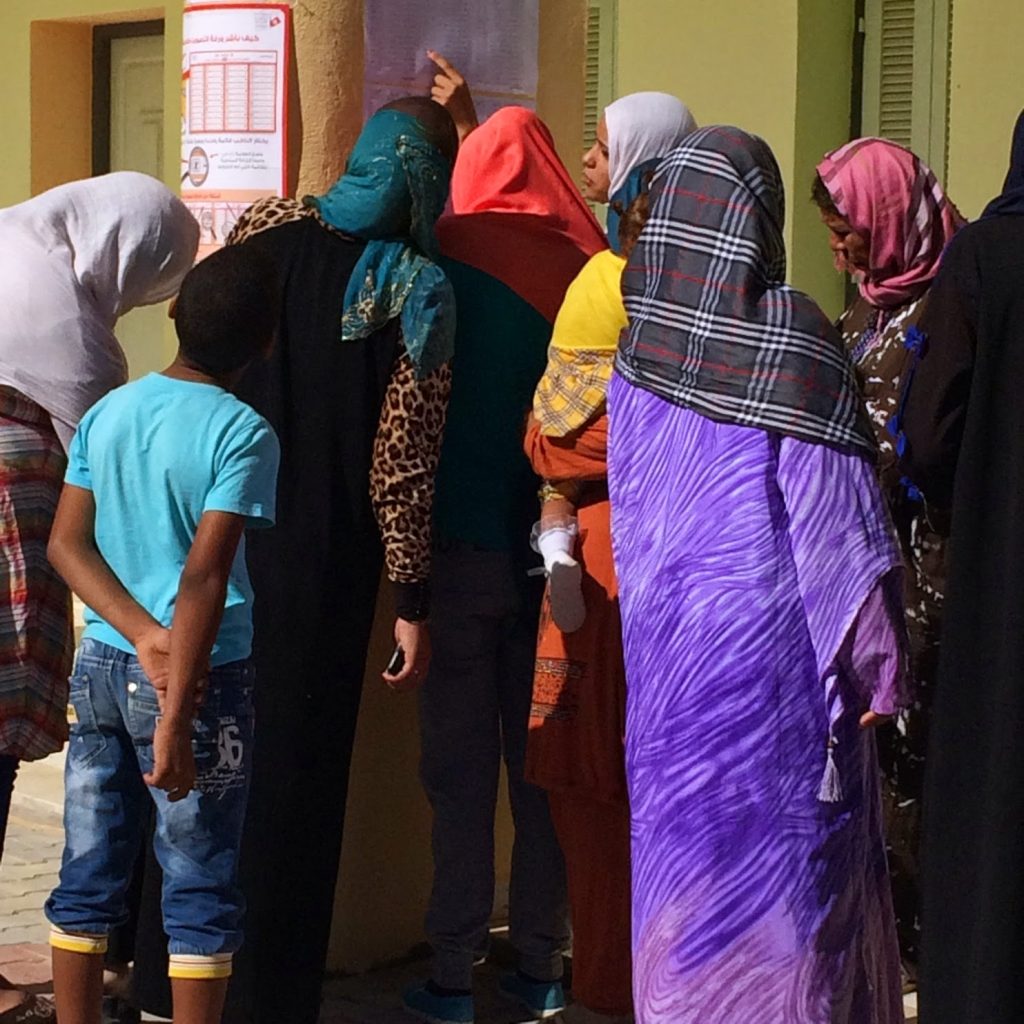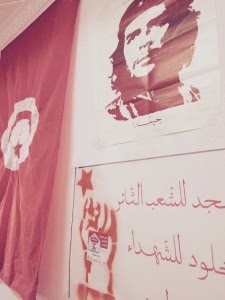 |
| Women look at candidate lists for parliamentary elections Oct. 26 in the Tunisian village of Chebika) |
hours after polls closed Oct. 26, marking Tunisia’s second democratic elections
after the Arab Spring. Nidaa Tunis is headed by the charismatic Beji Caid
Essebsi and is an eclectic conglomerate of cadres from the regime of former
president Zine el-Abidine Ben Ali, big business, left-wing intellectuals and
unionists. The party unseated Ennahda, the moderate Islamist party that swept
the 2011 legislative elections. For months, analysts and voters pitted Ennahda
against Nidaa Tunis, painting a polarized political field. Religion against
secularism appeared to be the name of Tunisia’s electoral game.
1,327 candidate lists vying for seats during the three week long campaign,
streets were crowded with boisterous rallies and clamorous parades,
representing a wide variety of reforms, programs and promises. Preliminary
election results reflect Tunisia’s political diversity with a third of voters
choosing between extreme leftists, determined capitalists and independents.
When glancing beyond the capital of Tunis to the country’s economically
challenged interior and south, a simplistic secularist over Islamist victory
does injustice to the richness of Tunisia’s shrewd post-revolutionary political
evolution.
neighboring mining town of Redeyef, lofty debates about religion and secularism
mean very little to residents. Unemployment in the area soars, and disgruntled
residents complain of no improvements since the 2011 toppling of Ben Ali,
blaming Ennahda’s governance as much as corrupt interests of the lingering old
guard in Tunis. Life in the mining region differs remarkably from that of
Tunisia’s capital, but to many residents and local leaders, Gafsa is where the
Tunisian Revolution began. In 2008, two years before the Arab Spring, a
six-month rebellion by unemployed minors, leftist activists and defected
unionists in the mining region was violently crushed by Ben Ali’s security forces.
The region was on fire as protesters took to the street every week,
fundamentally shaking the regime. Candidates from the region, especially
leftists, heavily lambast the post-revolutionary political elite for dismissing
the region’s longstanding political tradition. In Redeyef, a town dotted with
dilapidated buildings from the French colonial period and flimsy constructions
of the 1960s and 1970s, unemployment has reached an estimated high of 40
percent. Most affected are educated youth who desperately seek entry into the
phosphate industry. Phosphates extraction, production and trade constitute one
third of Tunisia’s economy, yet the industry is heavily controlled by the
Tunisian state, which has done little to reinvest in the region.
 |
| Poster of Argentinian Marxist Revolutionary Che Guevara hanging near a Tunisian flag at the Redeyef Office of the Popular Front. (Laryssa Chomiak) |
area has always been a bastion for politics concerned with workers’ rights and
economic equality. One of the region’s most celebrated local leaders, Adnen
Hajii, the so-called Che Guevara of the south, led the 2008 rebellion and has
now secured a seat in the 217-member parliament on an independent ticket. He
ran along-side the Popular Front coalition, an eclectic mix of 12 parties and
civil society organizations, inspired by mid-century intellectual Marxism,
Leninism, Arab and Tunisian Nationalism, and European-style social democracy.
Redeyef has historically suffered from underdevelopment and mismanaged economic
plans, yet its political vibrancy mirrors none other in Tunisia. Days before
the Oct. 26 elections, residents were out in full force, braving the unbearably
dry heat to welcome political celebrities. Leftist Hamma Hammami, the Popular
Front’s charismatic leader and long-time opponent of Tunisia’s first and second
presidents, Habib Bourguiba and Ben Ali, visited his loyal followers, many of
whom participated in the 2008 rebellion. A recent visit by Slim Riahi, leader
of the Free Patriotic Union party, businessman and president of Club African, a
popular Tunisian soccer club, captured a surprising amount of support by coming
in third, less so for his liberal economic affinities than his soccer profile.
Original campaigns by both political factions garnered them well over 10
percent of parliamentary seats, one of the elections’ surprises.
appeal following two political assassinations of leftist leaders – Chokri
Belaid and Mohamed Brahmi in February and July 2013, respectively. The second
assassination spiraled Tunisia into a political crisis and inspired a movement,
Rahil (Get out), which called for the resignation of the Ennahda-led Troika
government. Voters dissatisfied with both Ennahda’s performance and Nidaa
Tunis’s program have been drawn to smaller parties, from leftists to those with
clear liberal economic agendas. Discussing platforms with groups of leftists in
the sparse offices of the Popular Front or Hajji’s party on election day, the
mood was clear: Local economic needs trump all other ills.
and a heavy regulatory state dominated platforms and public speeches. The
Popular Front is first and foremost committed to democracy, principles of
social justice and economic equality. But its members cringe when you call them
leftists. They have a keen reading of politics: A retired philosophy teacher
who taught at a local school in Redeyef clarifies that leftist militancy served
a purpose before the Revolution, “it allowed us to unite and fight against Ben
Ali and his cronies.” With a smile he says, “Today we have become democrats, we
are pragmatic about Tunisia’s future.” The Popular Front, projected to have won
12 seats, wants to ensure a political balance between the leading factions in
parliament. “The Popular Front is an example of a party that represents
Tunisia’s most pressing needs and one that can function as a legitimate
counter-power in parliament by placing a check on both Nidaa Tunis and
Ennahda,” says Noaman Ben Ammar, a young, unemployed activist from Gafsa who
participated in the 2008 Rebellion and is now a member of the Popular Front.
Those who voted for leftists and other smaller parties are thrilled – not only
have their economic woes found a voice in the assembly for the first time, but
their decision to not vote “strategically” has paid off.
or the faulty perception that Tunisians are polarized on a religion-secularism
dichotomy, those who voted for the smaller parties are content.They understand
that in a nascent democracy, a wide variety of platforms with diverse promises
are more valuable than a clustering of interests around one or two political
factions. “I am a devout Muslim,” says a member of Hajji’s party from Redeyef,
“but I will only vote for candidates who represent the real dire needs of my
region. For us the only solution is a strong leftist voice in Tunis.” Painting
Tunisia as split between religion and secularism cheapens the country’s
extraordinary progress toward democratic pluralism.
stretched far beyond the ideological splits of religion versus secularism. Such
labels have become fashionable means to make sense of Arab Spring countries,
yet they don’t represent Tunisia’s fascinating political, if not democratic
reality. For the country’s south, which has been plagued by economic ills since
independence, there is hope. “For the first time,” says Ammar, “our needs are
represented in the assembly.” The proliferation of political parties and
extraordinary strength of civil society defining Tunisian politics following
the 2011 Revolution show that Tunisia’s democracy is, indeed, in its making.
Centre d’Etudes Maghrébines in Tunis. She is finalizing her upcoming book on
the politics of dissent under Ben Ali’s Tunisia and portions of her work have
appeared as book chapters and journal articles in Middle East Law and
Governance, The Journal of North African Studies, Portal
9 and Middle East Report.